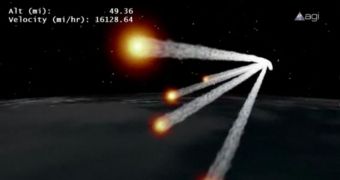During a fiery reentry that ripped it to pieces, the German-built Roentgen Satellite (ROSAT) came crashing down to Earth on Saturday, October 22. Astronomers tracking its reentry path are not yet sure where the spacecraft debris landed.
ROSAT has been “dead” for about ten years, languishing in a slowly-decaying orbit until finally it reentered Earth's atmosphere. The intense heat of the process set it ablaze, and burnt it until its structure failed entirely. The vehicle was then ripped to pieces.
Most of the latter burned up high above the planet's surface, but many of them made their way to the ground. At this point, experts cannot be sure as to where the junk fell, but establishing this for certain is only a matter of time.
According to scientists, the spacecraft crashed through the air between 9:45 pm and 10:15 pm EDT on Saturday (0145 and 0215 GMT on Sunday, October 23). The announcement was made by the German Aerospace Center (DLR), which managed the mission.
“There is currently no confirmation if pieces of debris have reached Earth's surface,” an official statement from the DLR reads. ROSAT weighed about 2.7 tons, which made it lighter than NASA's Upper Atmosphere Research Satellite (UARS), which crashed into the ocean a few weeks ago.
DLR investigators estimate that around 30 pieces of the defunct satellite may have made their way to the ground. These parts have a combined weight of around 1.9 tons (1.7 metric tons), and are mostly made up of ceramics and heat-resistant mirrors, Space reports.
The debris cone – extracted from the satellite's last known path – is now estimated to be around 80 kilometers (50 miles) wide, the German investigators explain. Most likely, the vast majority of debris now lies at the bottom of the ocean somewhere.
ROSAT launched in June 1990 with a very simple mission – study the X-ray Universe. This meant keeping an eye out for high-energy photons coming in from supernovae, black holes, comets, stars and nebulae. Though it was supposed to work for only 18 months, the satellite remained live for 8 years.
Back in 1998, following an error in the star tracker instrument aboard the spacecraft, its main detector was made to point towards the Sun. This compromised the entire satellite, which forced DLR experts to officially decommission it in February 1999.
Since then, mission controllers have known that the object is on an unsustainable orbit. Without the ability to adjust for altitude, it was only a matter of time before the spacecraft came crashing down.

 14 DAY TRIAL //
14 DAY TRIAL //